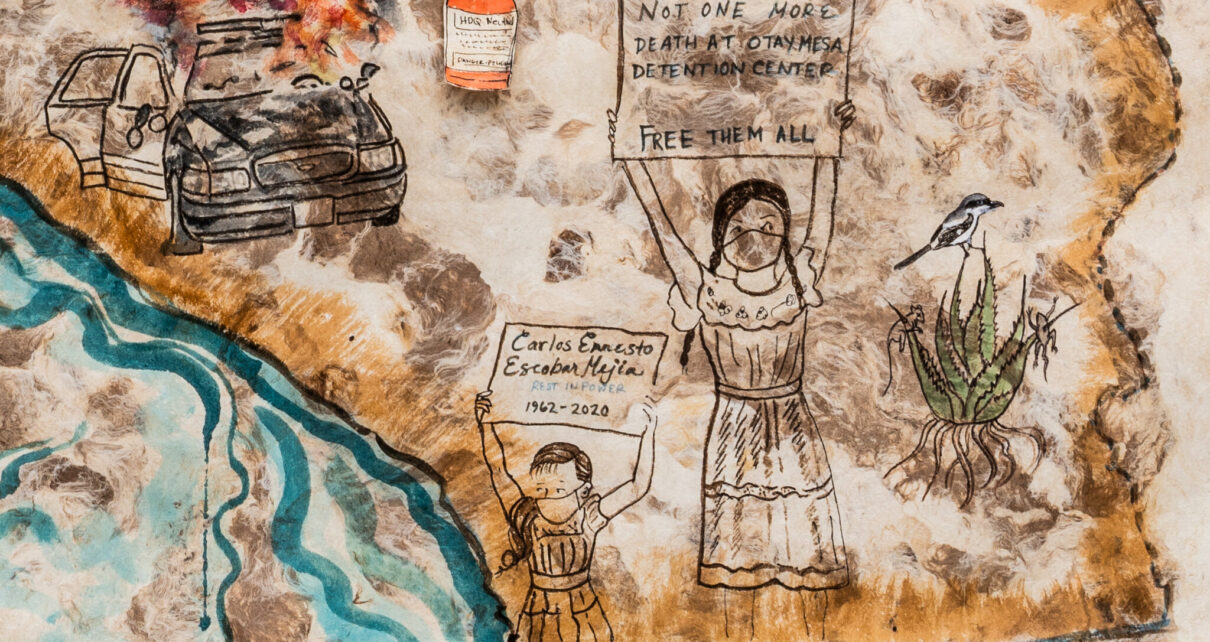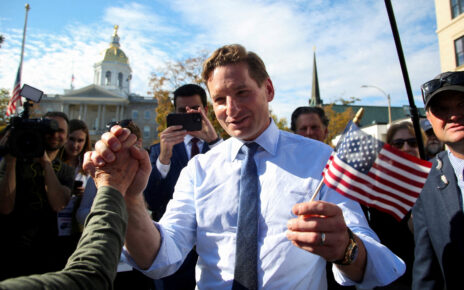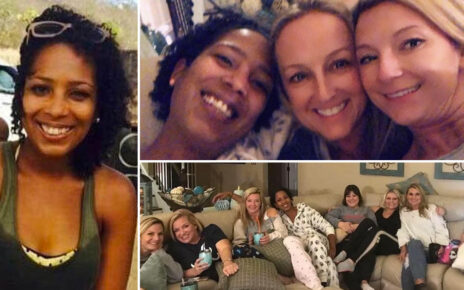
A note from adrienne maree brown: Aisha Shillingford is the collage artist-philosopher behind the Intelligent Mischief posts of possibility. As a Black futurist, she teaches through encouraged dreaming and spell-casting questions.
Many of us are becoming aware that we are living in an apocalyptic, revelatory moment. We are experiencing extreme contradictions as systems based on the white supremacist imaginary (domination, extraction, and violence) are failing.
If we are able to look at world events through the lens of history stretching over hundreds or thousands of years, we will recognize that we are in a time of great transition—a time when the world as we know it is ending and a new world is fighting to be born. For some, the falling away of the only systems they’ve known causes such great uncertainty and instability that they would do anything to protect the dying system. The end of the world as we know it causes grave distress and hopelessness.
But, as these systems crumble, in the cracks, there is an opportunity for us to insert another imaginary. There is an opportunity to create new worlds from the Black Imagination, freed from the capitalistic notion that our creativity can and should be exploited.
What’s Working
-
A Night Market Creates Opportunity for Black Communities
An evening market in Nashville provides a location for local Black business owners to sell goods and gain exposure.
In 2019, my studio embarked on a deep-dive study of the Black Imagination, inspired by Robin D.G. Kelley’s Freedom Dreams. We curated a list of readings looking to explore whether there were shared principles and methods by which Black- and Afro-descendant people have engaged in bold imagining and freedom dreaming, especially through art, literature, culture, and prefigurative experiments, as part of broader racial justice movements. We found that Black Imagination is an ancestral, Afro-Indigenous way of being based on various cosmologies. Black Imagination centers worldviews that are nonbinary and borderless. It affirms the interconnectedness between our material world, universal consciousness, the past, and our ancestors, the future, and those yet to be born. It is embodied and rhythmic and integrated. It presents many possibilities; it is non-monolithic, affirming multiple ways of being and knowing. It is interdependent and regenerative. It invites us to straddle worlds like Eshu Elegbara or Papa Legba the Trickster, Orisha of the crossroads; and to be like water, adaptable and abundant.
We access Black Imagination through our ancestral connection and guidance, and we experience it via our dreams, our collective visioning, our intuitions, and our stories. It invites us into the prophetic tradition of envisioning futures in which our descendants are thriving and free. The Black Imagination has been a source of hope and healing at key moments of transition in the history of the Western world, offering a vision of liberation that is expansive and inclusive; an alternative to the destruction brought about by white supremacy.
As an artist, I am especially deeply inspired by the idea of poetic futures outlined in Freedom Dreams. I understand it to refer to the aesthetics of articulating visions of liberatory futures. I am drawn to it because it helped to clarify and affirm for me the role of artists, writers, creatives, and cultural producers in advancing the bold and irresistible freedom dreams held by our movements for liberation at a time when I was embracing art as my purpose after more than 20 years as an organizer. It also contextualizes artists and creatives as integral participants in social movements, right alongside and in relationship to organizers and policymakers and academics. Under the stewardship of artists, radical ideas captivate the hearts and minds of even those who consider themselves nonpoliticized—making other possible worlds irresistible and perhaps inevitable.

These invitations are evident in the performances of Sun Ra and his articulations of a possible life for Black people on other planets. Or Du Bois’ The Comet, written in 1920, and the way in which it works out the “what if?” of racial equality in the context of a science-fiction novel. Or the Black Panther comic books and subsequent movies. This is the work of radical and visionary world-building, and it is what I am turning to in order to unleash my imagination and that of others.
World-building is a literary tool primarily used to shape science fiction, fantasy, and other speculative fictions. It can be a way to support Black folks to articulate their boldest political imaginations by reimagining and reconnecting to an ancestral sense of Spirit and Story: who we are and what we mean to the world. Building these worlds allows us to reimagine and reaffirm our shared values and ways of being together, in ways that center Black love, Black joy, Black rest, Black time. We can reimagine and redesign our neighborhoods and cities as liberated zones and decolonized spaces, and reimagine and transform our systems and structures—from governance, to economics, to education—to reflect our values.
For the past three years my studio, Intelligent Mischief, has been experimenting with using world-building as an art and design framework that invites Black communities to imagine futures based on seven-generations thinking. We see imagining the future as our sacred responsibility as future ancestors. We invite people to craft story worlds for their future descendants 150 years from now, and then imagine the future history—how we journey from the world we know, the now, to the worlds of the future. In so doing, we use world-building to support the development of long-arc strategy, as well as to create works of art and experiences that can inspire. We learn to anticipate ebbs and flows, ups and downs, and pushback, and we prepare to meet those challenges with our hearts planted firmly on a collective North Star. We draw on our desires to cultivate hope, and conjure artifacts and practices from the future that we can begin practicing now in order to make those possible futures real right now. By world-building, we are conjuring hope. Together we are painting vivid pictures of the world and inspiring each other to take bold and transformative action with whatever gifts we have to bring that world into being. As a collage artist, these worlds make their ways subconsciously into my artwork too.
In the three years that we’ve been cultivating this collective practice, we’ve learned a few precious lessons:
- Imagining the future is mostly about remembering and drawing lessons from the past. It’s also about giving ourselves space to change the present (or the near future). It allows us to temporarily let go of the feeling of the impossible that can exist in the present, and feel the power of creating conditions that allow more possibilities to unfold in the future. Once we can see these possibilities, regardless of when they exist in our imaginations, we can make them real in the now.
- We mostly know what new ideas we might try. Most of the ideas and solutions already exist from a technological perspective. In our world-building spaces, people echo some fundamental solutions. We mainly need permission to believe these ideas are possible at the level of our collective will. Expressing our desires together, in an affirming and hope-oriented community, gives us the confidence to mention these ideas in other places, and to experiment with them in our work in all aspects of society.
- We have a chance at saving our species from impending disaster if we can get diverse groups of people involved in imagining shared futures, mitigating the kind of uncertainty that breeds fear and violence. We need to collectively craft different stories and scenarios of the future, and commit to working toward some of those scenarios, instead of accepting the stories of scarcity and competition fed to us by people who do not wish for all of us to thrive.
- Collective imagination is essential. And we must build the power to co-create elements of the futures we have imagined. We have to allow our dreams to infect our realities, and allow them to shape the way we think about what we are building. Sometimes that is going to look like simple day-to-day practices and ways of being that embody our future visions in extremely practical ways. And sometimes it looks like changing the way we approach organizing and movement-building, including who we think our movements include.
As we face the uncertainty of transition, Black Imagination is an abolitionist tradition that offers us an invitation to act with hope. It invites us to remember that the key to our thriving exists in our collective dreaming and in our willingness to imagine the impossible. We remember then, that in times like these we have always advanced bold and inspiring visions by demanding transformative policies, creating innovative and prefigurative structures, and by creating visionary and speculative art and ways of being together. How might you create the space and time necessary to unleash Black Imagination, today?
 |
Aisha Shillingford is an artist, designer and world-builder living in Brooklyn, New York. She has a BA in environmental analysis and policy from Boston University, an MSW in social innovation from Boston College, and an MBA from Simmons University. She formerly served as lead organizer of of the Muslim American Society — Boston Chapter, and the Close To Home Domestic Violence Prevention Initiative, and is the former director of racial and economic justice at the New Economy Coalition, a former senior associate at the Interaction Institute for Social Change, and the former deputy director of innovation strategy at Movement Strategy Center. She is currently the Artistic Director of Intelligent Mischief, a creative studio unleashing the power of Black radical imagination to shape the future. She is also an Artist in Residence at the Laundromat Project, and in Fall 2023, will be an interactive telecommunications fellow at New York University.
|







